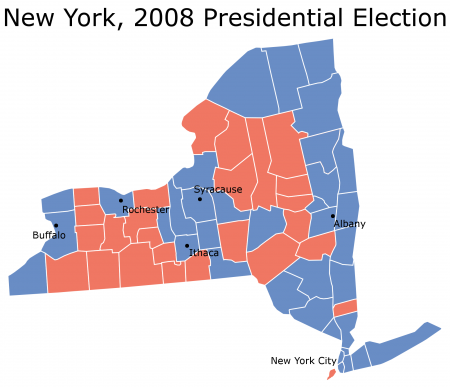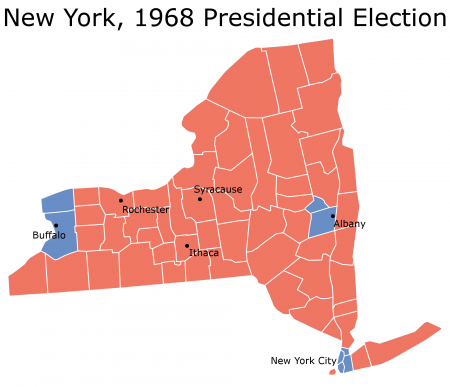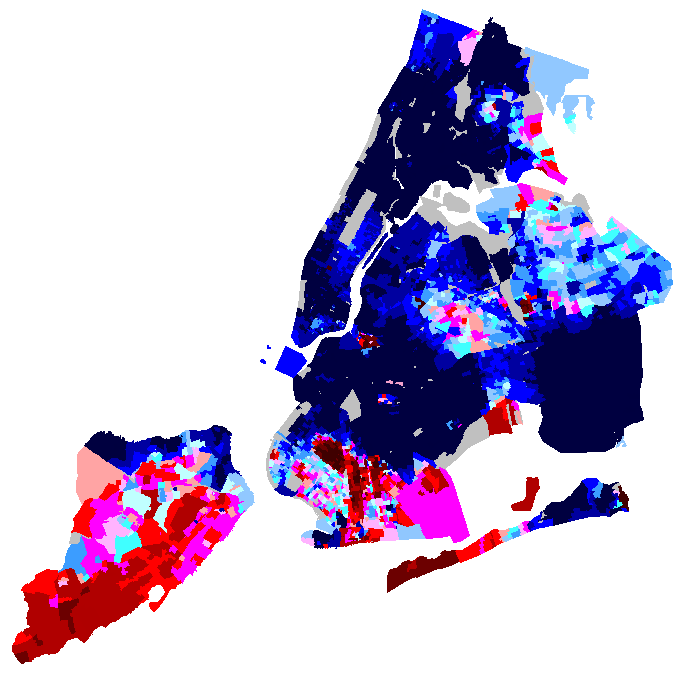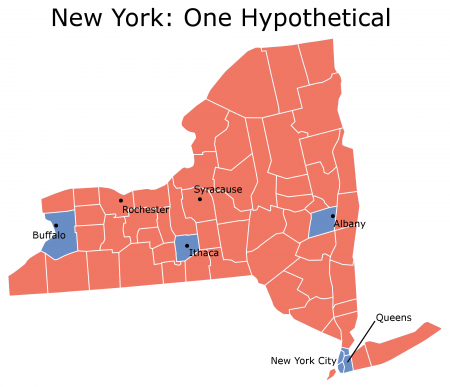This is the first part of a series of posts analyzing competitive Senate elections in blue states. The first part, which analyzes Illinois can be found here.
Out of the three heavily Democratic states being analyzed, Republicans probably have the least chance of winning New York. A serious Republican challenger to Senator Kristen Gillibrand has not emerged. Moreover, Ms. Gillibrand has proven an adept politician willing to campaign hard.
Nevertheless, in a bad national environment with low name recognition, victory for Democrats is not assured. Under the right circumstances (perhaps a Gillibrand scandal), Republicans may be able to pull off a shocker.
Like Illinois, New York can be divided into three sections: upstate, the suburbs downstate, and New York City. A New York Republican must win upstate and the suburbs by substantial margins – and perform extremely well in New York City.
More below.
Upstate New York
Like Illinois, the first step on the Republican road to victory lies with here. A Republican candidate must win strong margins upstate; a strong performance here is embedded with a double-digit loss.
Unfortunately for Republicans, upstate New York and downstate Illinois are not the same. Unlike Illinois, upstate New York is home to four major cities: Buffalo, Rochester, Albany, and Syracuse. In a normal election – i.e. a double-digit Democratic victory – these cities will vote Democratic, some by substantial margins.
There are several more wrinkles for a Republican candidate. Like much of the rural northeast, upstate New York has been trending Democratic. Despite the conservative national mood, Democrats last year won two special elections upstate. Moreover, Senator Kristen Gillibrand has roots there; she represented an upstate congressional district before becoming Senator.
Nevertheless, the majority of this region still votes loyally Republican; a competitive candidate can rely upon it to help counter New York City. In a close election a Republican ought to win almost every county in upstate New York.
The Suburbs Downstate
This region can be defined as the suburbs surrounding New York City: Long Island and the communities around Yonkers. A Republican’s task here is similar to that upstate: win, and win big.
Historically this was not too difficult; New York City’s suburbs regularly voted Republican, although never by enough to overcome Democratic margins in the city itself. Like many other suburbs, this changed with President Bill Clinton: since his time they have generally voted Democratic.
Today things are changing once more. Since the events of 9/11, downstate’s suburbs (especially Long Island) have been trending Republican. This was one of the few regions Senator John McCain did well in (as opposed to President Barack Obama doing poorly in); his national security credentials appealed to a number of downstate suburban voters.
A strong Republican must capitalize on this trend, changing New York’s suburbs back into Republican territory. This strength, added to margins from upstate, makes for a 5% Republican loss. Republican candidates have achieved this combination many times in the state’s electoral history. Take 1968, when President Richard Nixon lost New York by 5.46%:
The problem is the last 5%, to which a Republican must look to New York City for.
New York City
To make up the last 5%, a Republican candidate must do well in New York City, that great metropolis of the United States. The Big Apple composes an astounding 43% of the state’s population, the largest proportion in the country. It also votes extremely Democratic; in 2008 four out of five voters turned the lever for President Barack Obama.
The Republican facing Ms. Gillibrand will have to substantially improve upon this number. This is not as hard as it first sounds. New York City, after all, has had a non-Democratic mayor for more than a decade. Low minority turn-out looks likely to bedevil Democrats during this off-year election. Moreover, Republicans retain a base in Staten Island and southern Brooklyn. Even in 2008 these places voted Republican:
(Note: Image courtesy of a very old post from user jeffmd on swingstateproject.)
Finally, some regional complexities come into play. Although almost all of New York City voted for Mr. Obama, some parts are more less loyally Democratic than others (as was the case in Massachusetts). White liberals and impoverished minorities in Manhattan and the Bronx almost never vote Republican; suburbanites in Brooklyn and Queens, on the other hand, are more perceptible to Republican appeals. Winning Republicans generally tie or win the Queens borough and hold Democrats below 60% in the Kings borough.
Conclusions
If New York is close next November, it will probably look something like this:
This map can indicate anything from a 5% Democratic victory to a 5% Republican victory, depending on turn-out. Perhaps the best barometer will be the Queens borough in New York City. Look to it next November – it might literally determine the fate of the Democratic Senate majority.
–Inoljt, http://mypolitikal.com/



